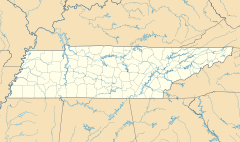Craighead Caverns
| Craighead Caverns | |
|---|---|

Anthodite Formation
|
|
|
Map of Tennessee
|
|
| Location | Sweetwater, Tennessee |
| Coordinates | 35°32′08″N 84°25′52″W / 35.53556°N 84.43111°WCoordinates: 35°32′08″N 84°25′52″W / 35.53556°N 84.43111°W |
| Designated | 1974 |
| Official website | |
Craighead Caverns is an extensive cave system located in between Sweetwater and Madisonville, Tennessee. It is best known for containing the United States' largest and the world's second largest non-subglacial underground lake, The Lost Sea. In addition to the lake, the caverns contain an abundance of crystal clusters called anthodites, stalactites, stalagmites, and a waterfall.
Located in the foothills of the Great Smoky Mountains, the caverns are named after their former owner, a Cherokee native American, Chief Craighead. The caverns were formerly used by the Cherokee as a meeting place and later they were mined by Confederate soldiers for saltpeter, a commodity necessary to the manufacture of gunpowder.
In 1939, explorers found the remains of a jaguar. The persons who made the discovery were cave guides Jack Kyker and Clarence Hicks, who were exploring in the cave during their off hours. They reported their find to Dr. W. J. Cameron and W. E. Michael of Sweetwater, who were the current owners of the cave. The owners submitted the bones to the American Museum of Natural History in New York City, where they were identified as bones of a very large jaguar and an elk fawn. George Gaylord Simpson, a vertebrate paleontologist at the museum, subsequently visited Craighead Caverns in May 1940. During his visit, he recovered additional jaguar bones and made casts of several jaguar footprints in the mud floor of the cave. His excavation and findings are reported in American Museum Novitates, No. 1131 (August 6, 1941) on pages 1–12. The report includes photographs of the bones and footprints.
...
Wikipedia

